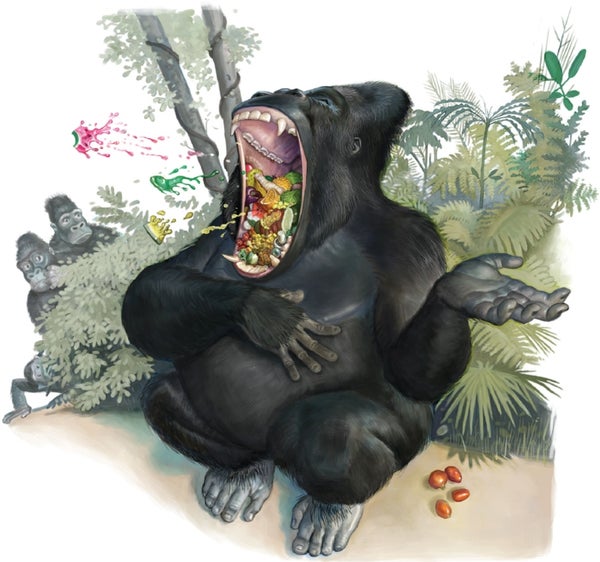Where, an old joke asks, does a 400-pound gorilla sleep? Anywhere it wants to, the superannuated gag answers. In keeping with that line of reasoning, a 400-pound gorilla should similarly hum anytime it wants to. The scientifically verified answer, however, is that the gorilla in question actually hums when he's eating—if the gorilla in question is a socially prominent male, anyway, according to a study recently published in the journal PLOS ONE. The humming sounds more like rumbling Dolby Audio in a theater showing a Fast & Furious movie than what you and I might come up with when we're doing the dishes. But it's definitely a hum coming out of that huge, hairy head.
The same study found that some gorillas may even sing when they're chewing on a favorite piece of vegetation. (And you thought it was impolite to even talk with your mouth full.) Gorilla singing doesn't approach the mellifluous stylings of, say, the Monkees, but it's vaguely musical, and the logical thing to call this sound that clearly isn't humming would be singing. Just as humans who perform “Aba Daba Honeymoon,” with the immortal line “Baba daba daba daba daba daba dab, said the monkey to the chimp,” are certainly singing, even if the work is “the nadir of all American expression,” according to Thomas Pynchon.
That gorillas produce such noises was not a total shock. “We know from studies on chimpanzees and bonobos that great apes produce certain vocalizations while they're feeding, so-called food associated calls,” said one of the authors of the new study, Eva Luef of the Max Planck Institute for Ornithology in Germany, in an interview for Scientific American's Science Talk podcast. “And our study wanted to investigate whether gorillas do the same.”
On supporting science journalism
If you're enjoying this article, consider supporting our award-winning journalism by subscribing. By purchasing a subscription you are helping to ensure the future of impactful stories about the discoveries and ideas shaping our world today.
So Luef and her colleagues trooped off to the Republic of the Congo to spend some time with two different populations of western lowlands gorillas, which have the easy-to-remember Linnaean subspecies designation of Gorilla g. gorilla. (See if you can guess what the “g” stands for.)
Primatologist Dian Fossey, who died in Rwanda in 1985, noted that gorillas hum and sang. She categorized such sounds as “belch vocalizations,” which often seemed to signal contentment—can you believe some people still don't accept that gorillas and humans have a common ancestor?
The current research, however, is the first to really track the vocalizations and connect them to specific behaviors. “And we found that it was [males—blackback adolescents and silverback adults—that] were the most frequent callers,” Luef revealed. “This is not surprising as adult males are usually the most frequent callers, concerning any gorilla vocalization. And then we found that the food calls were produced when they were feeding on certain foods. So aquatic vegetation or seeds elicited a lot of food calls. And… they never called when they were eating insects like termites or ants.” Because feasting on Formicidae or ingesting Isoptera is nothing to sing about. Even among gorillas.
So what's with all the Sturm und Sang? “We believe that the food calls have a social function in gorillas,” Luef said. “They may signal to [other gorilla] listeners that an individual is busy eating at the moment. Silverback males have a special role in gorilla society…. They are most often the ones making group decisions. So when the silverback sits and eats, the others eat as well. And [when] he gets up and starts to … travel in the forest…, the others follow him. So it makes sense for the silverback to signal to his group mates that he's still eating and then signal that he has finished eating when he stops calling.” In other words, humming and singing may be the dominant male's Do Not Disturb sign. And his eventual silence could be gorilla for “Ladies and almostmen, may I have your attention?”
In fact, Luef and her colleagues plan to do more in-depth analysis of gorilla vocalizations to see if they can learn anything about how we came to yap. They want to study “how the gorillas compose their food songs,” she said, “and whether they possess a certain repertoire of song notes, which they combine into their little food songs. That would be more similar to human language because [we have] a certain repertoire of sounds we can make, and we combine them into words and different languages. So if gorillas could do the same with their songs, that would just be amazing.” Aba daba indeed.
